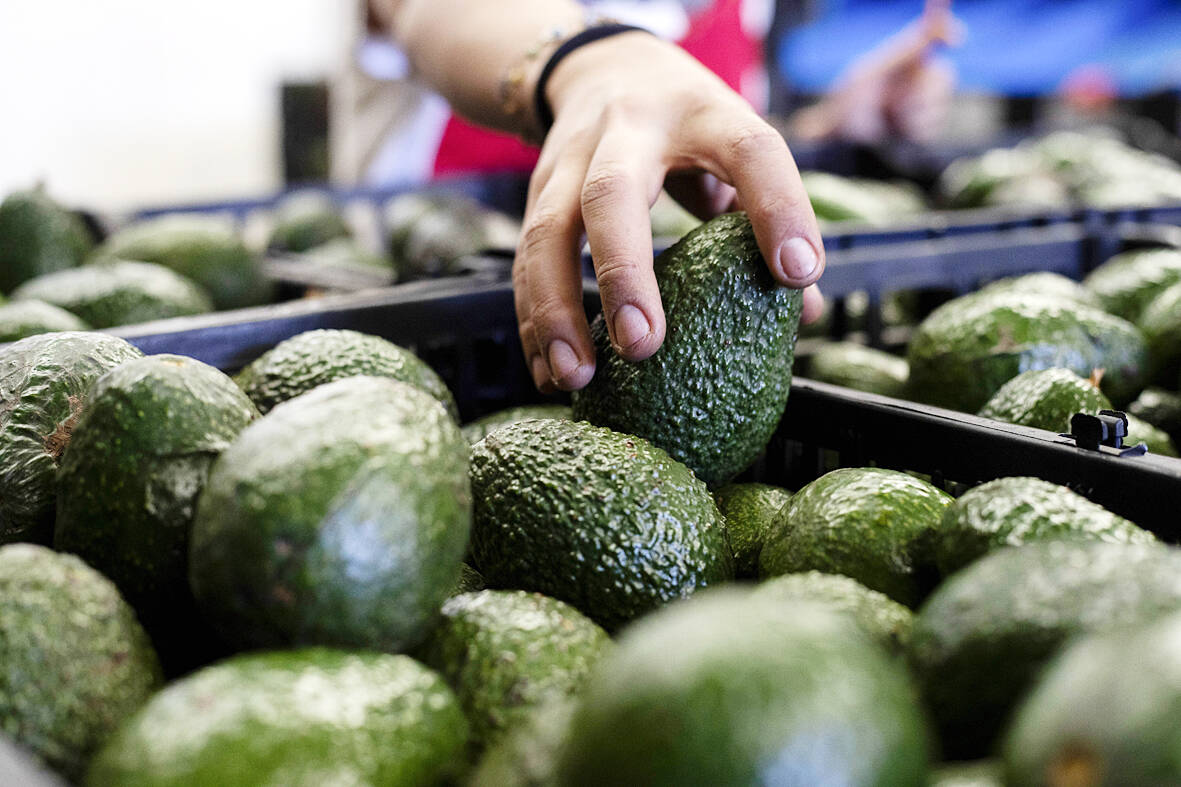It started with meat — burgers, to be precise. But now the moment for “smashed” food has come for everything from brussels sprouts to cucumbers, tacos and toasties. In restaurants and kitchens across the world, the sound of pounding can be heard as chefs and home cooks take rolling pins to their ingredients.
The smash burger — flatter and more crispy than the non-smashed — has been growing in popularity. Last year, experts declared smashed peas on toast the new avocado on toast. On TikTok, smashed cucumber recipes racked up millions of views this summer.
“It’s the word of the moment,” says Sami Harvey, executive chef at The Laundry in south London, where smashed roast squash is on the menu.

Photo: AP
But smashing is not the same thing to all people. While some chefs and food experts use it interchangeably with “smacked,” others keep things more delineated. According to Lisa Harris, from Harris and Hayes food and drink consultancy, smashed food is “pressed with a potato masher to increase surface area and optimize the Maillard reaction, which gives those delicious crispy bits … You want to compress food without destroying it.”
The Maillard reaction could be seen as the science of smashing. Described unappetizingly as the “nonenzymatic browning reaction,” it is responsible for the flavor of browned food. Harris thinks of “smacked,” which most commonly applies to cucumbers, as “a bit more haphazard — usually bashed with the back of a knife or a rolling pin until they break apart, before marinating them.”
There is a rationale for smashing a perfectly good ingredient. Chef Gizzi Erskine says that, in the case of burgers, “you’re using a high-quality, high-fat product, but [smashing] suddenly reduces its cost, it gets its seasoning better and it’s more of a consistent cook.”
Erskine also likes to smash new potatoes if she’s cooking at home.
“I’ve been doing that for years,” she says. I feel like that’s a Jamie Oliver thing from, like, 20 years ago.”
Surface area is key. Smashing “allows food to absorb marinades and dressings so much better,” says Helen Graham, who spent five years as executive chef at Bubala, a vegetarian Middle Eastern-inspired restaurant in London.
Julie Lin agrees. The Malaysian-Scottish chef has smashed dishes on the menu at her restaurant, Gaga, in Glasgow. She points to ayam penyet, describing it as a fried chicken leg smashed so that strands of meat become exposed.
“And then you smear a really spicy red sambal on it,” she says.
Because of the rocky terrain of a smashed dish, “you are going to get sauce clinging in different areas, and different flavor profiles with each mouthful,” says Ayesha Kalaji, chef patron of Queen of Cups, a restaurant in Glastonbury, which served smashed cucumbers this summer, mixing them with melons marinated in miso and almond, along with chilli oil made from Palestinian chilies and aleppo peppers. She is now adding a smashed jerusalem artichoke dish to her menu.
For her, a lot of the appeal is about the crispy texture that comes from smashing
The aesthetic of a smashed dish also appeals to some chefs. For Lin, “ugly delicious” food is preferable to anything too neat.
It is the “antithesis to fine dining,” says food expert Alice Grier. “We’re all craving comfort food, and this leans into that. And the aesthetics of it all makes it perfect for Instagram — a jumble of texture and color.”
Social media has helped the trend spread, with Instagram and TikTok key to which foods fly. Graham, who is currently into smashing parsnips, says: “Instagram reels and TikTok are incredibly influential on the way that we cook, and in turn what ends up on menus. I think chefs on Instagram are looking for simple, high-impact visual techniques to get people’s attention.” What’s more dramatic, or easier, than whacking some potatoes?
Harvey thinks smashing is a great way to use the kind of vegetable seen as “second-class … helping the farmers and the growers out. Just because they haven’t got something that’s really premium to the eye, it doesn’t mean it shouldn’t be served.”
“At the moment, it’s a very hostile environment for the hospitality industry,” says Kalaji. Food wastage is one of the “most important factors in cutting costs”, and “using the whole vegetable where possible is a massive element of that”.
“I think it’s definitely a way of making an ingredient stretch a lot further,” says Graham.
For some, pounding ingredients has a subtly anarchic appeal. “There’s something gently irreverent and disruptive about smashing up your dinner,” says Harris. “The inherent destruction-creation cycle of smashing things is therapeutic.”
Rukmini Iyer, author of the bestselling Roasting Tin series, agrees. For her cucumber and charred mango salad. she would put the cucumbers in a plastic bag. “And then I’d get a rolling pin out and start smashing. It’s quite cathartic,” she says.
But smashing doesn’t work for all ingredients. “Take a softer vegetable, such as an aubergine: you’ll end up with baba ganoush,” says Graham.
And Iyer has not had a great time of smashing broccoli.
Smashing food is far from new. “It has been part of Chinese cooking for a long time,” says Lin. And Graham cites the Lebanese dish musabaha: “Chickpeas are overcooked and then crushed and tossed with lemon juice, tahini, garlic and cumin.”
Kalaji came across a recipe for smashed spleen in one of the 14th-century cookbooks she read while studying Middle Eastern cuisine. Perhaps that one, though, is less Instagram-friendly.

The Democratic Progressive Party (DPP), Chinese Nationalist Party (KMT), and the country’s other political groups dare not offend religious groups, says Chen Lih-ming (陳立民), founder of the Taiwan Anti-Religion Alliance (台灣反宗教者聯盟). “It’s the same in other democracies, of course, but because political struggles in Taiwan are extraordinarily fierce, you’ll see candidates visiting several temples each day ahead of elections. That adds impetus to religion here,” says the retired college lecturer. In Japan’s most recent election, the Liberal Democratic Party lost many votes because of its ties to the Unification Church (“the Moonies”). Chen contrasts the progress made by anti-religion movements in

Taiwan doesn’t have a lot of railways, but its network has plenty of history. The government-owned entity that last year became the Taiwan Railway Corp (TRC) has been operating trains since 1891. During the 1895-1945 period of Japanese rule, the colonial government made huge investments in rail infrastructure. The northern port city of Keelung was connected to Kaohsiung in the south. New lines appeared in Pingtung, Yilan and the Hualien-Taitung region. Railway enthusiasts exploring Taiwan will find plenty to amuse themselves. Taipei will soon gain its second rail-themed museum. Elsewhere there’s a number of endearing branch lines and rolling-stock collections, some

Last week the State Department made several small changes to its Web information on Taiwan. First, it removed a statement saying that the US “does not support Taiwan independence.” The current statement now reads: “We oppose any unilateral changes to the status quo from either side. We expect cross-strait differences to be resolved by peaceful means, free from coercion, in a manner acceptable to the people on both sides of the Strait.” In 2022 the administration of Joe Biden also removed that verbiage, but after a month of pressure from the People’s Republic of China (PRC), reinstated it. The American

Chinese Nationalist Party (KMT) legislative caucus convener Fu Kun-chi (傅?萁) and some in the deep blue camp seem determined to ensure many of the recall campaigns against their lawmakers succeed. Widely known as the “King of Hualien,” Fu also appears to have become the king of the KMT. In theory, Legislative Speaker Han Kuo-yu (韓國瑜) outranks him, but Han is supposed to be even-handed in negotiations between party caucuses — the Democratic Progressive Party (DPP) says he is not — and Fu has been outright ignoring Han. Party Chairman Eric Chu (朱立倫) isn’t taking the lead on anything while Fu